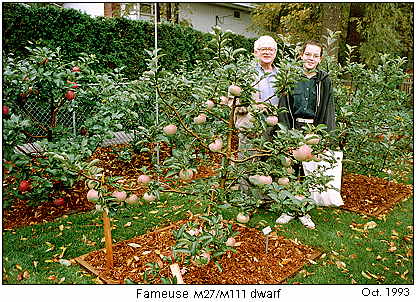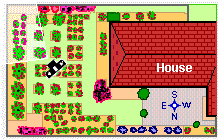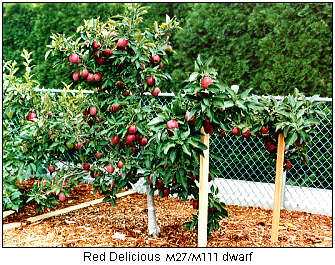Introduction – Blueberries – North Apple Bed – Panoramic View – Dwarf – Conclusion
Gene’s Answers – Train a Mini-Dwarf – Favorite Apples – Map of Backyard
Dwarf M27/M111 Apple Trees

Now imagine it’s a crisp October day as you walk from the north apple bed toward the southeast corner of Gene’s backyard. You’d view a scene like the one above.
Gene is standing behind ‘Fameuse’, also called ‘Snow Apple’ because of its snow-white flesh. It’s one of the oldest apple varieties known.
This tree is not a mini-dwarf but a M27/M111 dwarf, one of thirteen growing in Gene’s orchard. They are kept at 5 or 6 feet, but could easily grow larger. A M27/M111 dwarf is made up of 3 parts: a M111 rootstock which grows well in most soils and produces a tree 75 percent of standard size; a M27 interstem which further dwarfs the tree; and a choice apple variety which is grafted on top.

In the beginning Gene didn’t know how big a dwarf or mini-dwarf apple tree would be. So when he planted the mini-dwarf and happened to like the variety, he’d then planted the larger growing M27/M111 dwarf tree with that variety. The M27/M111 are not as readily available. Gene says, “I’ve moved away from them because I could put 4 to 6 apple trees in the same space as a strong growing M27/M111.”
Notice the size and spacing of apples on the tree. That’s because Gene thins them out. This brings up one of Gene’s hints, “Don’t let your tree overbear. Allow only one apple every 8 to 10 inches.”
On some of his younger trees and some of his mini-dwarfs, there are thin branches holding up 8-ounce apples. He uses wooden supports to prop them up. You can see these supports in this page’s photos. They are made from various lengths of 2×2 lumber into which he’s inserted “Y” shaped hooks found in any hardware store. He puts them out in late summer whenever he sees a branch that needs extra support.

This photograph is another M27/M111 dwarf. It’s the variety ‘Red Delicious’; one of the first trees Gene planted. This photo was taken years ago, when Gene wasn’t as thorough at thinning out fruit.